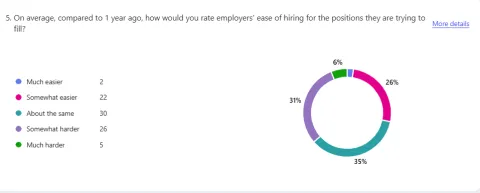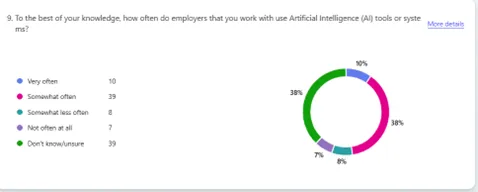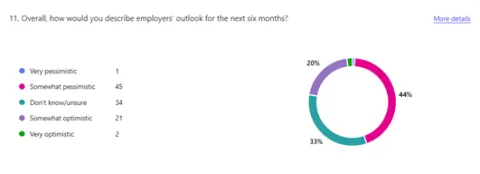
Survey responses are in from 103 workforce development and economic development staff who work with Minnesota employers; 85 of those respondents have worked with employers for at least one year. The survey was conducted the last two weeks in September 2025.
Roughly 36% of employer services staff who have worked with employers for at least a year (31 of 85 respondents) indicate that the employers they are working with are having a somewhat harder or much harder time hiring compared to a year ago. Of the remaining 54 respondents who have worked with employers for at least one year, roughly 28% (24) said it was somewhat easier or much easier for employers to hire and 35% (30) said it was about the same as a year ago.
This seems like a disconnect with responses from staff who work with job seekers: of the 294 respondents to that July 2025 survey who have worked with job seekers for at least one year, 33 (11%) said it was somewhat easier or much easier for the job seekers they serve to find employment, 86 (29%) believed it was about the same and 174 (59%) said it was somewhat harder or much harder to find employment compared to a year ago.
However, employer services staff may be more likely to serve employers who have positions that are more difficult to fill. And job counselor staff may be more likely to serve job seekers who have more challenges in finding employment. Whom staff serve could account for this disconnect in survey responses.
Response to September Employer Services Staff Survey by staff who have worked with Minnesota employers for at least one year:

There was some alignment between the staff responses regarding occupations it is easy to hire/hard to get hired for or hard to hire for/easy to get hired for. For example, employer services staff note it is easier versus a year ago for employers to hire for office staff positions, and job counselors say it is harder versus a year ago for customers to get hired for office staff positions. On the flip side, employer services staff say it is harder for employers to hire for healthcare support positions versus a year ago, while job counselors note that it is easier for the job seekers they server to get hired into healthcare support positions this year.
There was some alignment between staff perceptions of occupations that are easier or harder to hire for and those that are easier or harder for job seekers to get hired into. For example, employer service staff reported that it has become easier for employers to hire office staff compared to a year ago, while job counselors observed that it has become harder for job seekers to get hired into those same roles.
Conversely, employer service staff said it has become harder for employers to hire for healthcare support positions, while job counselors noted it has become easier for job seekers to find employment in those roles this year.
Top 3 occupational groups for which it is considerably easier to hire vs one year ago:
- Office support staff (Receptionists, Administrative Assistants, Accounting Clerks, etc.)
- Production and manufacturing workers (Machine Operators, Assembly Line Workers, Power Plant Operators, etc.)
- Food service workers (Chefs, Servers, Bartenders, etc.)
Top 3 occupational groups for which it is considerably harder to hire vs one year ago:
- Healthcare support workers (e.g., Nursing Assistants, Personal Care Aides, Medical Assistants)
- Healthcare specialists (e.g., Doctors, Nurses, Healthcare Technologists, Medical Records Specialists)
- Personal care workers (Hairstylists, Childcare Workers, Recreation Workers, Funeral Service Workers)
Another area of disconnection: job counselors surveyed in July said job security was the number one factor for job seekers and only one employer services staff respondent said it was most important factor. However, it is important to note we can’t compare survey results directly because we allowed for multiple responses on a similar question on the job search experience survey while on the employer services staff survey we only allowed one response about the most common benefit. This discrepancy will be resolved in surveys going forward.

Also of note: a large percentage (48%) of employer service staff say the employers they work with utilize artificial intelligence in some way. Of the 24 responses to an optional open-ended follow up question, 14 indicated that employers utilizing AI are using it for the hiring process, in particular for screening applicants.

Among all 103 employer services staff survey responses, 45% of respondents indicated that the employers they work with have a somewhat or very pessimistic outlook about the upcoming 6 months, while 21% had an optimistic outlook. The question did not allow for comments regarding the reason for pessimism or optimism.
- Looking for work or looking for workers? Contact staff at a CareerForce location near you.
- Employers: looking for specific assistance with finding the workforce you need, regional labor market information or other assistance? Meet your regional team.

